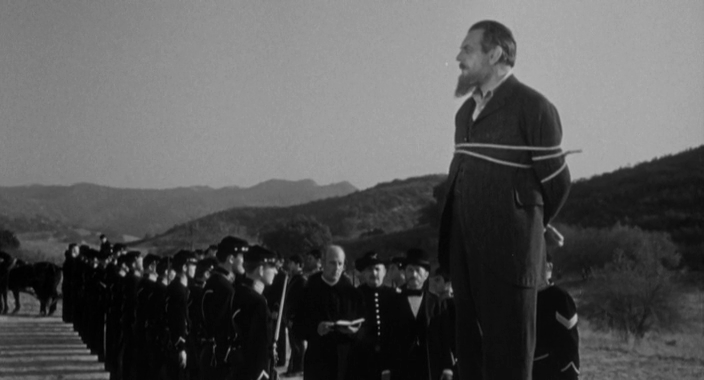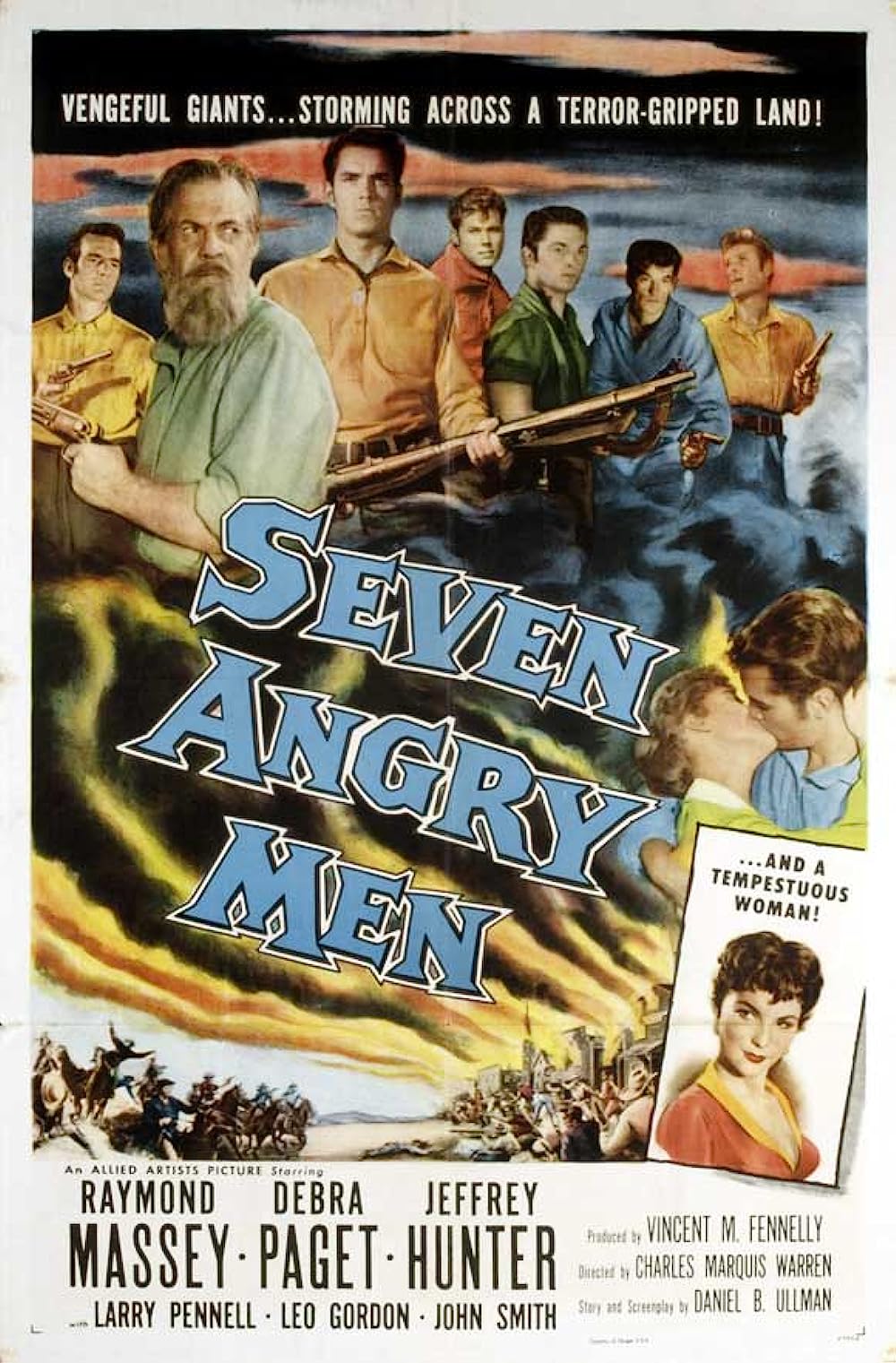[THE CHALK-OUTLINE]

Militant American abolitionist John Brown wages war on pro-slavery forces in Kansas and what-is-now West Virginia in the years leading up to the American Civil War.
Seven Angry Men (1955): Breakdown by The Hestinator (Brandon)
[THE GOOD, THE BAD, AND THEIR BADASSITUDE]
THE HEROES:

Raymond Massey as John Brown
The man. The myth. The legend. He’s John. He’s Brown. It’s John Brown, the greatest American who ever lived. A “conductor” on the Underground Railroad (something the film doesn’t mention), he and his large family travel to the territory of Kansas to help the anti-slavery faction there win a low-intensity conflict against those who want the area to enter the United States as a slave state. A fearless Calvinist warrior in the Cromwellian mold (minus the baggage of genocide against the Irish, of course), John Brown has abolitionism in his very soul and treats African-Americans as equals. At a time when the anti-slavery moment was timid and peaceful, Brown stands out for his willingness to use violence to stop the spread of the plague of human bondage and even to directly free slaves. Raymond Massey’s resolute performance as “Osawatomie Brown” is just about as perfect as you could ask for, capturing the stern fighter’s determination, religiosity, and idealism.
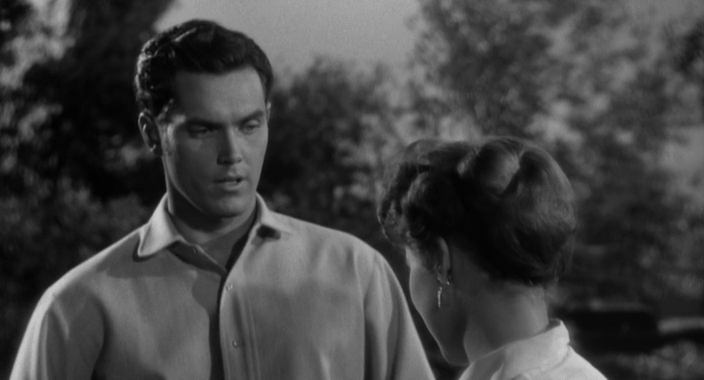
Jeffrey Hunter as Owen Brown
Owen Brown is one of John Brown’s approximately fourteen thousand children. Okay, Mr. Brown “only” had twenty children, but he sure kept his two wives busy (no, he wasn’t married to them at the same time!). Anyway, Owen’s not comfortable with his dad’s violent tactics, and hesitates to join him on his anti-slavery crusade. He’ll come around.
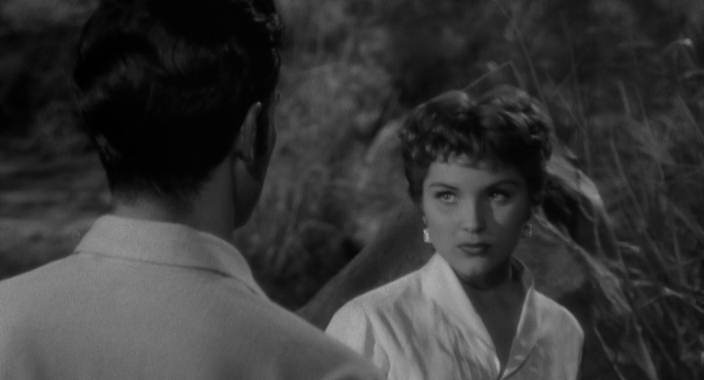
Debra Paget as Elizabeth Clark
The daughter of a Lawrence, Kansas, merchant, Elizabeth Clark is inserted into the story of John Brown to give Owen a love interest and somebody to talk to about his disagreements with his father’s methods. The movie’s poster promises that she’ll be “A TEMPESTUOUS WOMAN!,” but she’s really just more annoying than anything else.
THE VILLAINS:
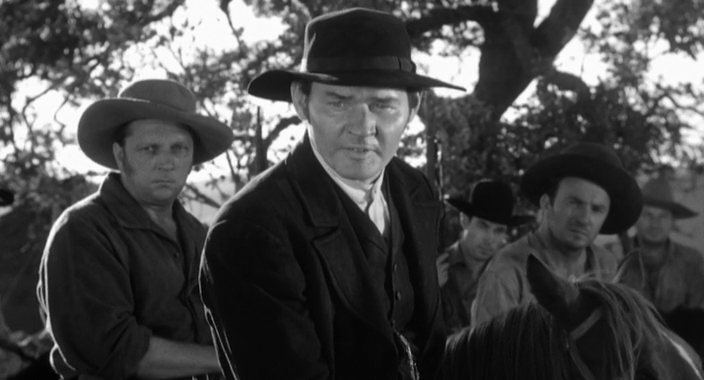
Leo Gordon as Martin White
Pro-slavery border ruffian Martin White serves as the bad guy for the Bleeding Kansas segment of the film. This evil bastard isn’t given much depth, he just leads the local band of partisans who want Kansas to enter the Union as a slave state. His gang of brutes are responsible for the Sack of Lawrence and launch an assault on the Browns’ settlement as Osawatomie. Sure, he’s a nasty piece of work, but he won’t go down as one of cinema’s great villains or anything like that.

Robert Osterloh as Robert E. Lee
It probably seems a little too convenient for the future leader of the Confederate army to square off against the greatest White abolitionist of the antebellum years, but this is rooted in fact. When John Brown and his followers undertook a raid to seize the federal arsenal Harpers Ferry, Virginia (now West Virginia), it was actually Robert E. Lee who was sent to defeat the abolitionist forces. Robert Osterloh’s performance as Lee here is nothing memorable.
[THE SEX AND VIOLENCE]
DUDESWEAT AND MACHISMO:
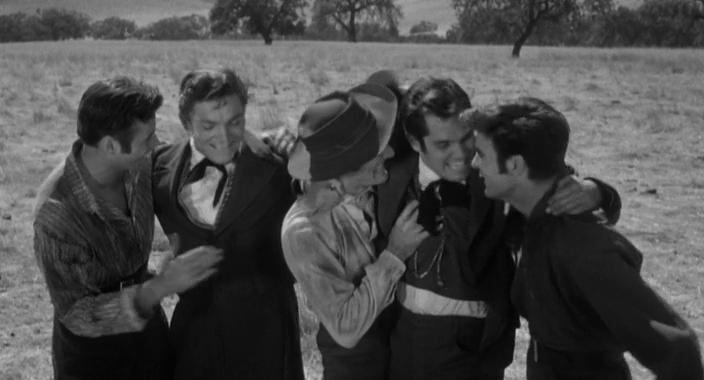
This is an American 1955 motion picture about John Brown, so there’s no dudesweat in sight, unless you count some of the gentle roughhousing among the main character’s kids.
EXPLOITATION AND MISOGYNY:
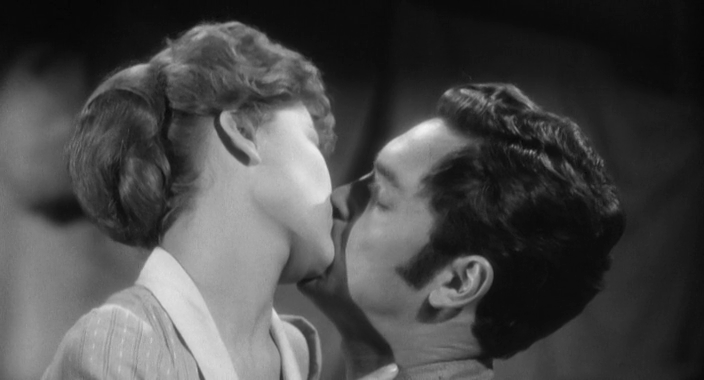
The film’s not outright sexist, in my opinion, but the female characters are pretty worthless in terms of impact on the plot. Elizabeth Clark (Debra Paget) exists solely to put a young woman on the poster. She doesn’t really approve of violence to end slavery and her scenes slow down the narrative to a considerable degree.
MURDER BY NUMBERS: [ 34 ]
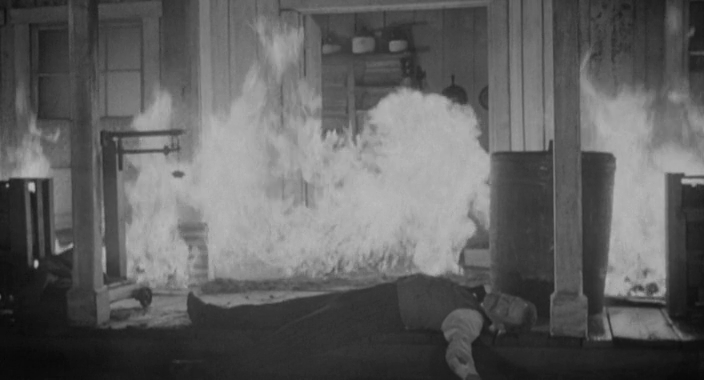
Thirty-four people meet their maker in Seven Angry Men, which is not a bad number at all. During the Sack of Lawrence scene, four innocents are killed (in reality, only one pro-slavery raider hit by some falling debris died during the Lawrence sack). However, it is mentioned in dialogue that five anti-slavery settlers were butchered during this event. Next, three pro-slavery homesteaders are executed by John Brown’s band during the Potawatomie Massacre (with two other dead mentioned in passing, but not shown). Frederick Brown (played by John Smith) is murdered by some border ruffians. Eleven attackers (including Martin White) are gunned down at the Battle of Osawatomie. Fourteen people, including abolitionist warriors, hostages, armed townspeople, and federal troops, are killed during the raid on Harpers Ferry. John Brown is hanged at the end. Overall, the violence in this movie is very tame, with blood only rearing its head on a couple of occasions in very mild quantities.
MOST SATISFYING ASS-KICKING AND/OR DEATH:
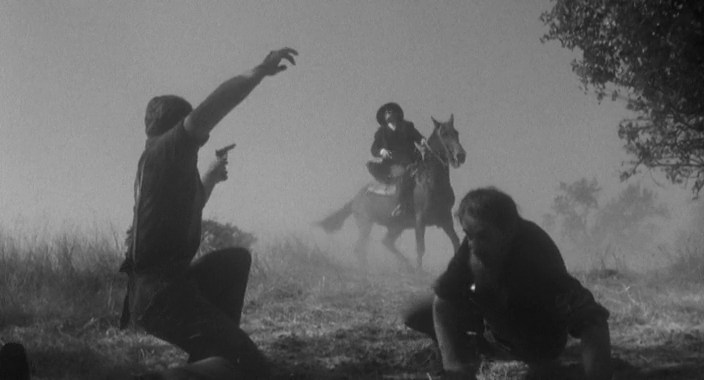
It’s relatively slim pickings for this category, but Martin White receiving not one, but two, bullets during the Battle of Osawatomie sequence comes to mind. As I said earlier, this an American production from the ‘50s, so the carnage is going to be restrained. Seeing some bad guy get shot twice is just about as hardcore as you’re going to get for the time period.
[THE BEST OF THE REST]
EPIC MOMENT:
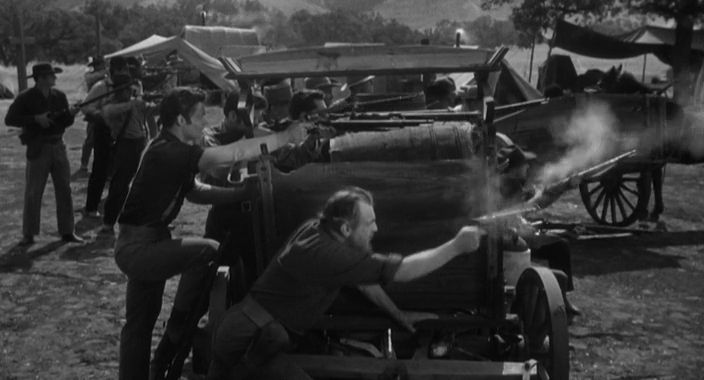
The Battle of Osawatomie
The firefight at the town of Osawatomie was the engagement of Bleeding Kansas that made John Brown an icon to some people in the Northern United States. After blasting one of his sons, Frederick, in cold blood, Martin White’s band of cutthroats launch a horse charge against Osawatomie, the settlement where the Browns reside. The defenders of the community take up arms and it’s on. It’s not exactly a great battle scene, but it’s enjoyable seeing so many pro-slavery fighters being shot off their horses. Although the vile attackers capture the village, they suffer heavy losses. John Brown, meanwhile, is casually moseying away from the battle like he’s on a Sunday walk, with Martin White hot on his tail. Of course, White gets plugged twice before he can do in our hero.
BEST LINE:

John Brown (Raymond Massey): “I am now quite certain that I am worth inconceivably more to hang than for any other purpose.”
After the failure to spark a slave rebellion in the South by capturing the federal arsenal at Harpers Ferry, John Brown is jailed. He’s put on trial and sentenced to death, but now he realizes he’s more valuable to the cause of abolitionism as a martyr than as a warrior. He delivers the above line to Owen Brown and gets led out to the gallows to be hanged, with “John Brown’s Body” playing on the musical score. It’s not in the movie, but philosopher Ralph Waldo Emerson (played by Selmer Jackson in the film) said that Brown “will make the gallows glorious like the Cross.” You can consider Brown giving himself up to have his neck stretched as Epic Moment #2.
[THE EXECUTION]
The 1955 biopic Seven Angry Men was not the first time that Raymond Massey played John Brown on the silver screen. Previously, he portrayed the heroic abolitionist in Santa Fe Trail (1940), a venomously racist western where Brown is the villain and slaves don’t want to be free. While that flick’s moral value is non-existent, it is somewhat watchable for its action scenes. Earlier, Massey also played Brown in the 1953 Broadway play John Brown’s Body, which was directed by Charles Laughton.

To be honest, Seven Angry Men often looks like a b-movie. However, if it is a b-movie, it’s one with one Hell of a story. The story of avenging angel John Brown is simply too powerful to resist and the film does an okay job of sticking to the facts. The first half of the production deals with Bleeding Kansas, a miniature civil war in Kansas Territory over whether it would enter the Union as a free or slave state. It most resembles a western movie in these scenes. The second half is about the build-up and execution of Brown’s raid on Harpers Ferry, Virginia, to acquire arms for a slave revolt that would start in Appalachia and hopefully spread to the rest of the South. Brown was inspired by tales of the “maroons” in Jamaica – societies of ex-slaves living in the mountains of the island – to try to start his own in the Appalachian Mountains.
Running about ninety minutes, not every aspect of Brown’s life makes the cut. There are a couple of exciting episodes of the icon’s life that are omitted, like the Battle of Black Jack and a raid into Missouri to rescue some slaves. I guess that they couldn’t be placed into the story without the narrative coming across as unwieldy. The movie is far more historically accurate than Santa Fe Trail, though, although this wasn’t at all a difficult task to pull off.
Seven Angry Men provides food for thought for discussion on the nature of politically-motivated violence. When is it okay to use violence to achieve political ends? In the film, as in real life, John Brown and his men uses lethal force to combat slavery, an unusually evil institution. Were they justified in what they did (I’d say “Hell yes!”), and, if they were, are they any other instances of acceptable political violence? For what appears to be a simple b-western at first glance, this flick grapples with some heavy topics.
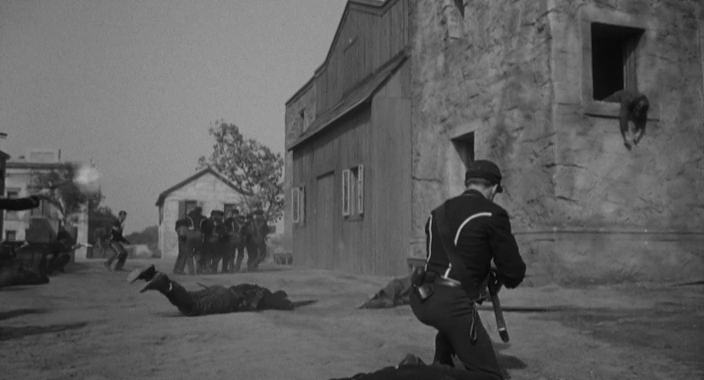
The Black follower of Brown in this movie, Ned Green (James Edwards), is treated with respect and dignity. He’s probably based on Shields Green, nicknamed “Emperor,” a former slave who joined Brown on his attack on Harpers Ferry. On an interesting sidenote, Green actually has his own film, Emperor (2020), which is pretty damn historically inaccurate, if entertaining. This picture features James Cromwell as John Brown and a Raiders of the Lost Ark (1981)-style wagon chase. Dayo Okeniyi plays Shields Green in it.
While in prison, Brown was offered rescue attempts to save him from the gallows. One of the potential operations was apparently going to involve abolitionist James Montgomery. If that name sounds familiar, it’s because he’s a character in the American Civil War combat film Glory (1989), where he’s played by Cliff De Young. Unfortunately, that otherwise-brilliant movie slanders Montgomery’s reputation by portraying him as a racist opportunist, whereas he was a sincere anti-racist in real life.
The biggest flaws with Seven Angry Men are the scenes involving Debra Paget. They really bring the pacing to a screeching halt and come across as boring. They keep this film in eight-outta-ten territory, as far as quality ratings go. Also, what’s up with the shitty title? I mean, yes, John Brown and six of his sons are pissed about slavery, but couldn’t the producers have come up with something a bit more thrilling? We’re still two years away from 12 Angry Men (1957), so the garbage title wasn’t made to cash in on that picture’s success.

Action-wise, there’s not a whole lot to write home about. This movie is “action-adjacent” at most, but the moments of physicality do stick reasonably close to the historical record. Still, it’s hard to go wrong with a film that has John Brown as its hero. No law, no man, no government, no institution can stop this guy (well – up until he gets hanged, that is).
Seven Angry Men isn’t quite the definitive biopic of John Brown, but it might be the closest we have at the moment. For its budgetary restraints and occasional historical inaccuracies, it’s an exceptional, little movie. It’s still-relevant and still-entertaining. I own what appears to be an original-release poster of the flick that I bought at a nearby antique store and have visited the Osawatomie and Black Jack battlefields in Kansas, the former of which houses a small museum on Brown. Sorry, I just had to flex on you like that.
[THE MORAL OF THE STORY]
You’re not in Santa Fe Trail anymore, Toto…this is real deal where John Brown did nothing wrong. You want John Brown’s body, don’t you?
[THE AOBG ACTION CHECKLIST]
[ ] Athlete(s) Turned “Actor”
[ ] Clinging To The Outside Of A Moving Vehicle
[ ] Crotch Attack
[X] Dialogue Telling Us How Bad-Ass The Main Character(s) Is/Are
[] Ending Featuring An Ambulance, A Blanket, Or A Towel
[X] Factory/Warehouse/Castle*
[] Giant Explosions
[] Heavy Artillery
[] Improvised Weapon(s)
[X] Macho Mode(s) Of Transportation
[X] Main Character Sports Facial Accessory(s)
[X] Manly Embrace(s)
[] Notorious Stunt-Man Sighting
[] Passage(s) Of Time Via Montage
[X] Politically Fueled Plot Point(s)
[] Senseless Destruction Of Property
[X] Shoot-Out(s) and/or Sword Fight(s)
[] Slow-Motion Finishing Move(s)/Death(s)
[X] Stupid Authoritative Figures
[] Substance Usage and/or Abuse
[] Torture Sequence(s)
[] Unnecessary Sequel
[] Vehicle Chase(s)
[X] Vigilante Justice
*An old-timey fire engine house counts as a warehouse, right?
[TOTAL: 9 outta 25]
